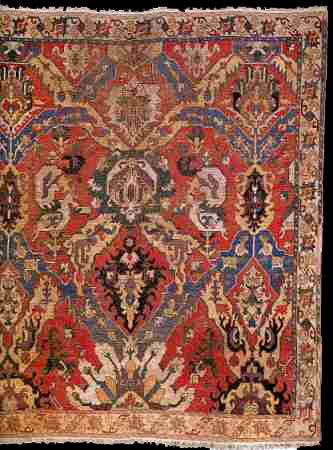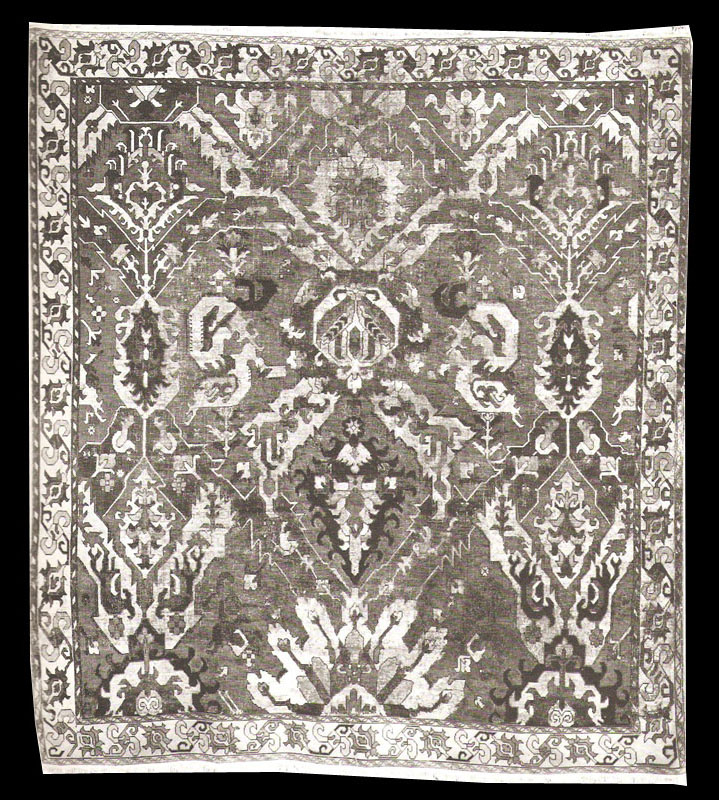|

 |
Fragmentary Dragon rug with Balanced Design and Sunburst Center, Karabagh
or Shirvan, early 18th century, late Safavid Period, Shirvan or Karabagh Province (Beylerbeyi),
Azerbaijan. Dr. Murray I. Eiland, Jr. 270 x 300m
published Oriental Rugs from
Pacific Collections, Plate 231
Merely the upper portion of this carpet survives, remarkably broad for an
early Caucasian rug. Perhaps it represents a half, if the original design
below has reproduced what we see at present, mirror-fashion. It would
produce a very stubby format, although we might consider that the elements
of the lost lower half may not have been so compressed as they appear here.
The very prominent sunburst which intruded upon the design at its center, or
somewhat above the center, is a highly unusual feature in a dragon
rug-scheme, but not unique and seems to have provoked several modern copies.
The field is a bricky or brownish scarlet. One band system is light yellow
and the other light medium to medium blue. The sunburst is ivory white. Its
yellow center is ringed by-violet and orange petals, from which extend
blue-green stalks which bear orange buds. Beside it on the side axes are
large enigmatic forms with hooked outlines: apparently the bases of
palmettes placed upside down. These are mainly violet on yellow on
black-brown. On the yellow "leaves" above these palmettes are black-brown
pheasants, poorly drawn.
In the red half-panels between sunburst and palmette the dragon or lion, its
normal arena now too constricted, is replaced by a queer, blue-green blob.
The ducks are violet, with yellow wings. The ivory dragons have black-brown
tails. The design continues in the manner of the lower portion of a drop
repeat dragon rug pattern which has been inverted. It closes with two
strangely spreading small ivory palmettes between the usual plaques.
The border stripe displays the same vine with diagonally placed palmettes as
in Plate 7, on ivory. Changes in the colors from rug to rug produce a
different effect. There arc narrow7 guard stripes in blue, with short
stretches in red, carrying a ribbon vine in red and yellow.
The dragons are similar in drafting to those of Plate 7 and the small rug
formerly in the Siesta Collection mentioned with it, but are more
close-coupled. Dressing the dragon's body with several colors is not
infrequent, as in Baron Thyssen's carpet (Beattie 1972: Pl. XI). The
centralized, mirror-image layout has perhaps come closest to that of the
Sharpies carpet of the Philadelphia Museum of Art (Turner et al. 1973: p.
31), the central blazon having been replaced by the sunburst. Palmettes
similarly inverted on the side axes half way along the design seem to have
also existed in a strange dragon rug that was owned by the dealer Gourko in
Paris in 1928. In all of these rugs a stiff, palmette form replaces the
concentric rosette on the side axes at the level of the dragons. The central
sunburst occurs in a very degenerate dragon rug in the Kest-ner Museum,
Hannover (H. Erdmann 1966: Abb. 27).
This fragmentary carpet, found in the Paris market, appears to be the
long-sought parent of a series of rather small, mirror-image modern "dragon
rugs". Campana (1945: PL 82") illustrated one as "Hereke". Kurt Erdmann
pictured one several times (1935: Fig. VII: 1900; Fig. 101) before he
realized its true age and nature. Several have come to the surface in
England. From one seen in a country house there we learn of cabled warp of
very fine ivory cotton, presumably machine spun. (Z5Z)3S and weft of Z2S
ivory cotton, a knot count of 180 to the square inch. The dimensions were
approximately the 9' x 6'4" of the rug shown by Erdmann. One imagines that
this series was made in Paris, as was a "Persian animal carpet of the 16th
century" with similarly compound, machine made warp which passed from a
"French Collection" into one of the best-known collections in the Middle
West many years ago.
Warp: Z2S wool in ivory and in a light range of natural shades. Two levels.
Weft: Z2S wool in light natural ranges, dyed light red. Two shots. No
singles noted.
Pile: 2Z wool. Gordes knotted, pile slanting to right. 7 or 8, or 8 horiz. x
7 or 6 or 8 1/2 vert. (49, 51, 68 per sq.in.).
Sides: Remains of red wool selvage on 3 or 2 cords. Inner cord a single,
weft attached.
Ends: Cut.
Colors: Ivory; black-brown; light yellow; dull yellow-orange; scarlet;
medium blue (abrashed light medium); blue-blue-green; dark green; medium
violet.
Condition: Entire lower portion lost, with a new run of border added; outer
guard stripe at upper end is also new, with some reweaving of this stripe at
the sides. Severely worn, with much pile replacement and in-painting.
Published: Oriental Rug Co. Newsletter, Berkeley, Vol. IV, No. 1, Jan. 1975.
Fig. 8. |


